Polytrichum commune
Polytrichum commune Hedw.
Family: Polytrichaceae
Common names: common hair cap moss
Introduction
Polytrichum commune is one of the largest mosses in southern Africa and can grow up to 25 cm high. Its stiff, narrow leaves are spirally arranged at right angles to the wiry stem, giving the plant a star-like appearance when viewed from above.
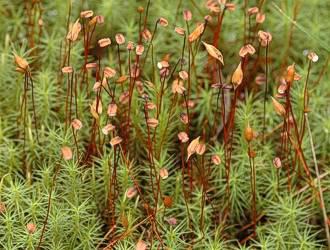
Description
Description
Plants of P. commune form loose to dense turfs in locally frequent to dominant colonies. The wiry plants are large and olive to dark green, becoming brown with age. Stems are typically unbranched, 2-25 cm high, stiff, erect or decumbent (lying down with ascending tips).
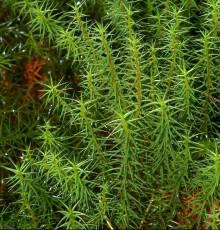
A microscopic cross section of the stem reveals a column of water-conductive tissue consisting of central hydrom and outer leptom, corresponding to xylem and phloem of vascular plants respectively.
Leaves are spirally arranged at right angles to the stem; 6-8 (-12) mm long; spearhead-shaped; erect-spreading to curved and twisted when dry, spreading with recurved tips when wet; the base clasps the stem with a membranous, shiny sheath, oblong-lanceolate or elliptical, yellowish; margins with unicellular teeth from leaf base to apex; the midrib ends above the apex in a short, toothed awn; a cross section of the leaf shows the upper or dorsal surface with 20-55 vertical ridges of cells called lamellae, (4) 5-9 cells long, with apical cells distinctly enlarged and notched centrally, thick-walled and photosynthetic.
The male inflorescence consists of enlarged heads at the stem apex.
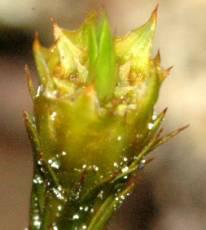
The female inflorescence frequently gives rise to a sporophyte (which produces spores in a capsule on a stalk) at the tip of the stem. Perichaetial leaves (surrounding female inflorescence) are reduced with a relatively long sheath, acuminate apex and toothed margins. Seta (capsule stalk) 5-9 cm long, wiry, yellowish to reddish brown.
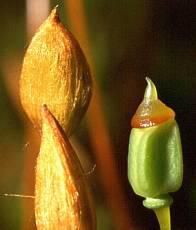
Capsule 3-6 mm long, inclined to horizontal with age, almost rectangular and distinctly 4-angled, giving it a box-like appearance, brown to dark reddish brown, constricted below to a distinct hypophysis (swollen neck). Operculum (capsule lid) about 1.5 mm long, short-beaked. Peristome (a circular structure inside the mouth of the capsule) of 64 short, rounded teeth. Calyptra (capsule hood), long, densely hairy and yellowish or golden brown. Spores very small, usually released in summer.
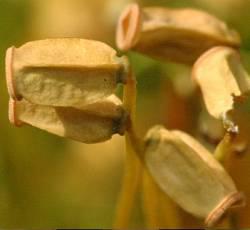
Conservation Status
Status
None.
Distribution and habitat
Distribution description
Polytrichum commune is found throughout the world in a diversity of habitats. In southern Africa it is known from Limpopo, North-West, Mpumalanga, Gauteng, KwaZulu-Natal, Free State, Eastern Cape and Western Cape Provinces of South Africa as well as Swaziland and Lesotho. It occurs in forest, grassland, savanna and fynbos biomes. In southern Africa P. commune frequently grows on gravelly soil and steep banks of road cuts, and on soil among grass along stream banks. It is also found near or along forest margins, on soil over rock outcrops, and at the edge of marshes. It occurs in wet places or more xeric (drier) areas, in light to dense shade or full sunlight, on gentle to steep slopes, at 280 m-2 865 m.
Derivation of name and historical aspects
History
The name Polytrichum is derived from the Ancient Greek words poly meaning many, and thrix meaning hair. This refers to the long, golden brown, densely hairy calyptra that covers the young capsule, a distinguishing feature of the genus. Polytrichum contains about 70 species of which 11 are recognized in Africa and four occur in the Flora of southern Africa area.
The 4-angled, box-like capsule of P. commune, with its distinct swollen neck, is very characteristic. When sterile, P. commune is easily distinguished by the upright, unbranched, wiry stems and the long, stiff leaves with toothed margins and awn, very wide midrib, and notched or grooved apical cells of the lamellae.
Ecology
Ecology
Polytrichum commune (and the genus) is characterized by photosynthetic, vertical lamellae on the upper leaf surface which is a xeromorphic adaptation to dry conditions. To minimize water loss, moist air is trapped between the inner rows of lammelae while the large, terminal cells exposed to the environment cotain moisture, and protect the photosynthetic cells. Under dry conditions the leaves of P. commune curve and twist as another way to minimize water loss. The teeth on leaf margins are also presumed to be another xeromorphic adaptation or perhaps a defense mechanism against invertebrate predators. The lamellae also provide a microenvironment for microscopic organisms e.g. fungi and rotifers.
Unlike other mosses, P. commune is endohydric — water is conducted from the plant base. The characteristic water conductive tissue of this moss is analogous to that of vascular plants.
The genus is known to be pollution tolerant and is frequently found in disturbed areas. The species is a bioindicator of acid soils. P. commune grows in association with other mosses e.g. species of Fissidens, Campylopus pilifer, Atrichum androgynum, and vascular plants like Lycopodium cernum and species of Selaginella, Erica and Drosera.
Uses
Use
Records of local uses of this moss are lacking. In other parts of the world P. commune is used in medicine, horticulture, household crafts and cosmetics. See the online ebook Bryophyte Ecology http://www.bryoecol.mtu.edu by Janice Glime for examples. The ecological uses of the genus include stabilizing of sand dunes.
Growing Polytrichum commune
Grow
There is no recorded information of cultivating mosses locally. However, in countries like Japan P. commune is used extensively in moss gardens. For more information about the cultivation of mosses please visit the website or blog http://www.mountainmoss.com/blog of Annie Martin of Mountain Moss enterprises, North Carolina, USA.
References
- Crum, H. & Anderson, L.E. 1981. Mosses of Eastern North America 2:. New York.
- http://tolweb.org/treehouses/?treehouse_id=3364
- http://www.bbsfieldguide.org.uk/content/polytrichum-commune-var-commune
- http://www.bryoecol.mtu.edu
- http://www.ohio.edu/plantbio/vislab/moss/giallombardo.htm
- Noguchi, A. 1987. Illustrated Moss Flora of Japan 1: 50 - 51. Hattori Botanical Laboratory.
- Vitt, D.H., Marsh, J.E. & Bovey, R.B. 1988. Mosses, Lichens and Ferns of Northwest North America: A photographic Field Guide. 56. Alberta.
Credits
N. Phephu & J. van Rooy
Pretoria National Herbarium
August 2011
Plant Attributes:
Plant Type: Moss
SA Distribution: Eastern Cape, Free State, Gauteng, KwaZulu-Natal, Limpopo, Mpumalanga, North West, Western Cape
Soil type: Sandy
Flowering season:
PH: Neutral
Flower colour:
Aspect: Full Sun, Shade
Gardening skill: Challenging
Special Features:
Horticultural zones











Rate this article
Article well written and informative
Rate this plant
Is this an interesting plant?
Login to add your Comment
Back to topNot registered yet? Click here to register.